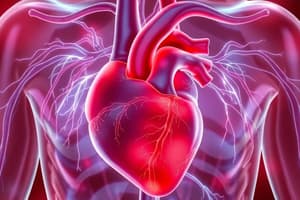Podcast
Questions and Answers
What is a significant finding during the inspection of the pericardium that may indicate cardiac disease?
What is a significant finding during the inspection of the pericardium that may indicate cardiac disease?
- Presence of bruising on the chest
- Normal heart rhythm detected
- Increased respiratory rate
- Abnormal pulsation such as lifts or heaves (correct)
Which technique is primarily used to assess the presence of abnormal pulsations in the pericardium?
Which technique is primarily used to assess the presence of abnormal pulsations in the pericardium?
- Radiological imaging
- Inspection and palpation (correct)
- Auscultation
- Percussion
What can be a symptom of cardiac disease that relates to the examination of the heart apart from pulsation abnormalities?
What can be a symptom of cardiac disease that relates to the examination of the heart apart from pulsation abnormalities?
- Leg swelling or edema (correct)
- Intermittent fever
- Frequent urination
- Persistent headache
When inspecting the pericardium, which of the following findings would NOT be expected?
When inspecting the pericardium, which of the following findings would NOT be expected?
In the context of heart auscultation, which area is critical for evaluating pericardial abnormalities?
In the context of heart auscultation, which area is critical for evaluating pericardial abnormalities?
What is the recommended technique for palpating the apical pulse?
What is the recommended technique for palpating the apical pulse?
How should you apply pressure when palpating the apical pulse?
How should you apply pressure when palpating the apical pulse?
When palpating the apical pulse, what area should be focused on?
When palpating the apical pulse, what area should be focused on?
Which physical examination technique is effective in detecting cardiac disease symptoms?
Which physical examination technique is effective in detecting cardiac disease symptoms?
Which method is NOT used for assessing the heart during a physical examination?
Which method is NOT used for assessing the heart during a physical examination?
Where does the apex of the left ventricle usually touch the chest wall?
Where does the apex of the left ventricle usually touch the chest wall?
What technique is primarily used for assessing the apex of the heart during a physical examination?
What technique is primarily used for assessing the apex of the heart during a physical examination?
Which area is typically auscultated to hear the sounds of the left ventricle?
Which area is typically auscultated to hear the sounds of the left ventricle?
Which of the following is NOT a common method for assessing heart conditions?
Which of the following is NOT a common method for assessing heart conditions?
During a cardiac examination, what is typically assessed through inspection and palpation?
During a cardiac examination, what is typically assessed through inspection and palpation?
Flashcards are hidden until you start studying
Study Notes
Heart Assessment: Inspection
- Inspect and palpate the pericardium for abnormal pulsations such as lifts or heaves, which may indicate underlying cardiac issues.
Palpation Techniques
- Use a gentle touch when palpating the heart area to ensure patient comfort.
- To locate the apical pulse, place the ball of your hand on the precordium, then transition to your fingertips for a more precise palpation.
Anatomical Landmarks
- The apex of the left ventricle is typically situated near the fifth left intercostal space (LICS), slightly below the left nipple, serving as a key landmark for assessment.
Studying That Suits You
Use AI to generate personalized quizzes and flashcards to suit your learning preferences.




